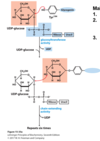Unit 9 Glycogen and Glucogenesis Flashcards
(22 cards)
Where is glycogen stored?
Muscle (for muscle used) and liver (for distribution)
Where is glycogen located? What is the overall structure of glycogen?
- Stored as granules in the cytosol
- Branched, with 12-14 glucose residues
- 2 chain types, α-(1→4) linkages of 12-14 glucose and α-(1→6) linkages branching off every 5th-6th glucose residue (therefore about 2 branching points per chian)
- Glycogenin in centre

What is the polarity of glycogen?
2 ends; a reducing end (1’ OH, since it can tautomerize into aldehyde and be reduced) and a non-reducing end (4’ OH)

What is special about the α-(1→4) linkages in glycogen, in terms of its affect in overall structure?
1→4 bonds introduce curve in the polymer; ensuring compact packing w/n cells
What are the steps of UDP-glucose synthesis?
1) G6P (From hexokinase) is conveted into G1P by phogopglucomutase (recall: mutase changes positions of functional groups)
2) Using UDP-glucose phophorylase, G1P reacts with UTP to form UDP glucose & pyrophosphate. This is the commited step; almost irreversible
What are the steps of forming a new molecule of glycogen from UDP-glucose?
1) Glycogenin protein (serving as a primer) attacks UDP glucose’s 1’C using Tyr194 (this is using glycosyltransferase activity)
2) Ather that, another molecule of UDP glucose can be attached to the 4’ end of the existing sugar using chain-extending activity
3) Process repeats 6 times, for a total of 7 glucose residues

How are existing branches of glycogen extended?
Glycogen synthase catalyzes the extension of existing branches, creating new α-(1→4) bonds

How are new branches of glycogen formed?
Glycogen-branching enzyme takes a 7-glucose residue from an existing chain from the non-reducing end, then connects it to the inner portion of the same chain to form a α-(1→6) bond
The existing chain MUST be at least 11 residues long for this to occur

What is the point of branching in glycogen?
To increase solubility
How is glycogen broken down?
- Glycogen phosphorylase adds orthophosphate to glucose reducing end (phosphorolysis), producing G1P and a shortened glcogen chain
- Glycogen phosphorylase continues until 4 residues away from branching point
- Debranching enzyme works in 2 ways;
- Transferase acitivity shifts 3 of the 4 residues to the “lower” 1→4 chain
- glucosidase activity cleaves the remaining glucose, releasing glucose
- G1P is conveted to G6P by phosphoglucomutase
What are the fates of G6P?
- Glycolysis (muscle)
- Dephosphorylated by glucose 6-phosphatase and released as glucose into the blood for use by other tissues
- Pentose phosphate pathaway to form ATP and NAD(P)H

What is the Cori cycle?
Reformation of pyruvate and glucose from Lactate; lactate from muscle put into blood and put into liver where it is converted lactate→pyruvate→glucose (lactate dehydrogenase)
Glucose released and carried back to muscle
Uses energy

How does gluconeogenesis from proteins occur?
Excess dietary protiens (or during times of starvation), protein can be converted into pyruvate or Kreb cycle intermediates and form oxaloacetate, which are used for gluconeogenesis
Acetyl-CoA cannot be used; cannot enter cycle (oxaloacetate not avaialable). Lipids also are not usable, as they are oxidized to acetyl-CoA as well

How can glycerol be used in gluconeogenesis?
Glycerol comes from triglyceride; glycerol can be converted into DHAP which can be turned into glucose
What are the 3 gluconeogenesis bypass reactions? What is so special about them?
- PEP generation
- Fructose-6-phsophate generation
- Glucose generation
These steps are steps 1, 3, and 10 in glycolysis; these steps were irreversible so another reaction to bypass them are necessary
How is PEP generated (bypass reaction)
- Pyruvate is combined with bicarbonate and carboxylated by pyruvate carboxylase into oxaloacetate (uses 2 ATP per one glucose, since 2 pyruvates need to be converted). THis occurs in the matrix
- Oxaloacetate transported via conversion to malate (recall malate dehydrogenase), transported into cytosol, then converted back to oxaloacetate
- Oxaloacetate converted into PEP with PEP carboxykinase (PEPCK) using GTP as energy (releases CO2)

How is F6P regenerated? (Bypass reaction)
Fructose 1,6-biphosphatase hydrolyzes phosphate of C1, yielding fructose 6-phosophate
How is Glucose regenerated? (bypass reaction)
G6P turned back into glucose by Glucoese 6-phosphatase, but only in the liver
What are the net reactions of glycolysis and gluconeogenesis?

How is pyruvate carboxylase regulated?
Inhibited by ADP
Activated by Acetyl-CoA
How is phosphoenolpyruvate carboxykinase regulated?
Inhibite by ADP
How is Fructose 1,6-biphosphatase regulated?
Hormone regulated; activated by glucagon, inhibited by insulin
Activated by citrate
Inhibited by AMP


